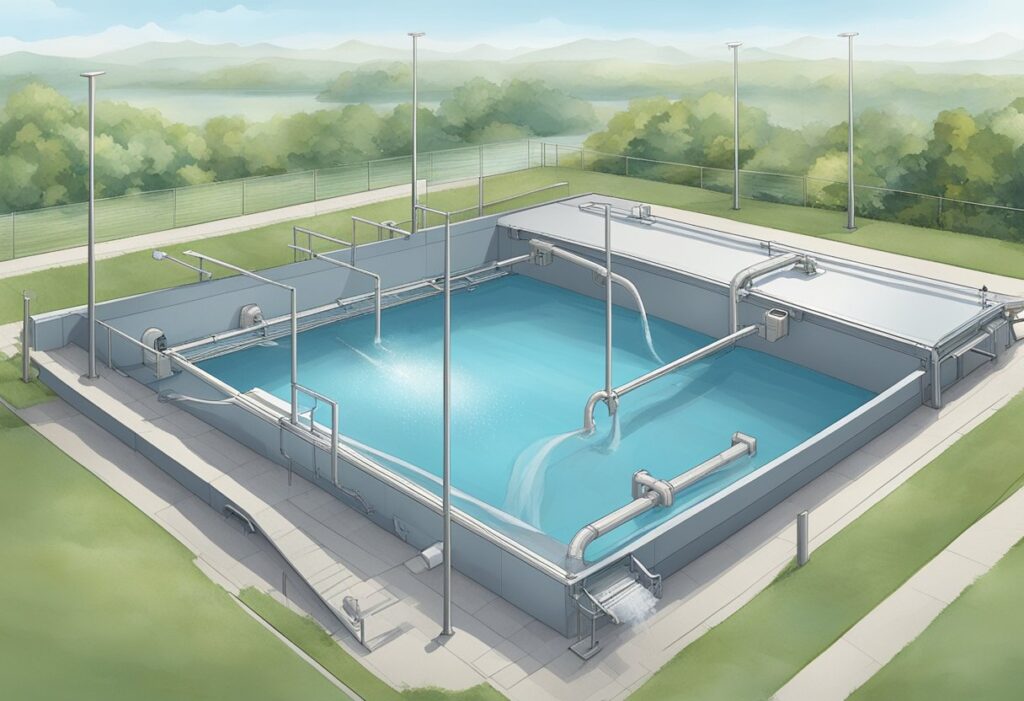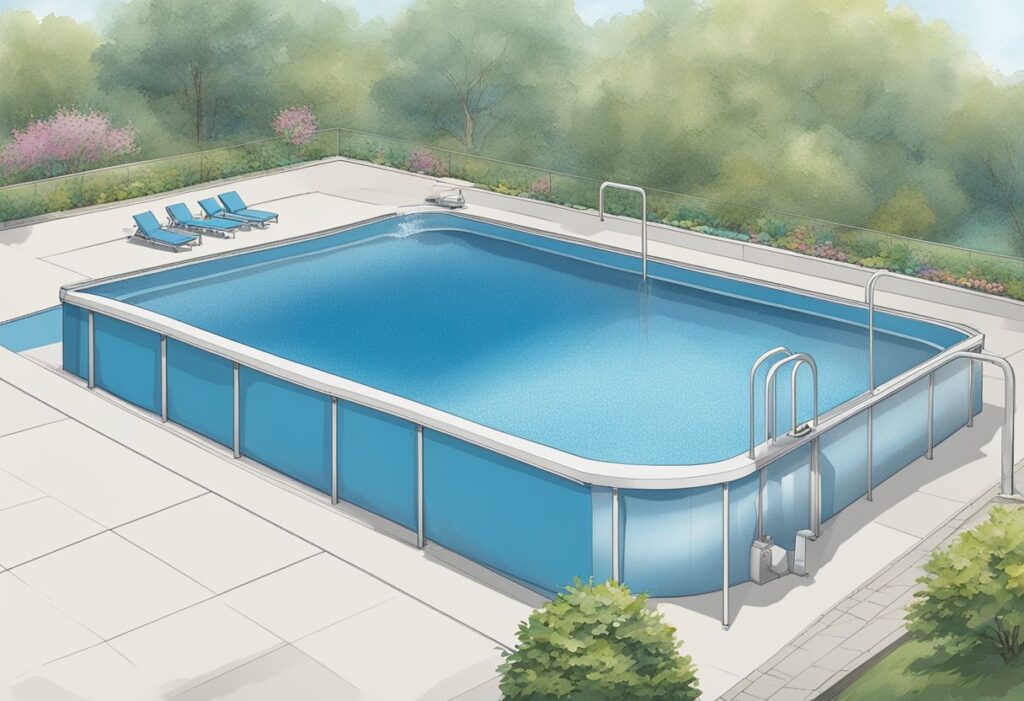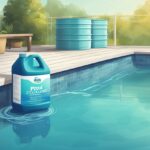Maintaining a crystal-clear swimming pool is crucial for both aesthetic appeal and hygiene. Pool clarifiers are specialised chemicals designed to assist in clearing cloudy water, a common issue faced by pool owners. When small particles in your pool, such as dirt, algae spores, and bacteria, escape the filtration system, they can cause the water to appear murky. Pool clarifiers work by coagulating these tiny particles into larger clusters that can then be more easily captured by your pool’s filter.

The debate between using pool clarifiers and flocculants, another type of pool cleaning agent, is centred on effectiveness and convenience. Clarifiers are typically easier to use because they allow you to maintain the regular operation of your pool’s pump and filtration system. On the contrary, flocculants require the particles to sink to the bottom of the pool for removal, which necessitates additional work such as vacuuming the pool floor.
Your choice between these two pool treatments might rest on the specific cleaning needs of your pool and the amount of effort you’re willing to invest. While flocculants can act more quickly, clarifiers offer a more user-friendly approach with gradual, yet steady results. Evaluating factors like the severity of the water cloudiness and the capabilities of your pool’s filtration system will guide you to the right product for keeping your pool water sparkling clean.
Understanding Pool Clarifiers
When your pool water becomes cloudy, employing a pool clarifier can be an effective solution. This section delves into how clarifiers function, their chemical makeup, and their distinct differences from flocculants.
Mechanism of Action
Pool clarifiers work by coagulating microscopic particles in the water. This process transforms these particles into larger clumps, making them large enough to be captured by your pool’s filtration system. By using a liquid clarifier or clarifier tablets, you enhance the efficiency of your filter, helping to restore clarity to the water.
Chemical Composition
The main components of pool clarifiers are polymers. Polymers are long-chain molecules that interact with the tiny particles suspended in your pool water. They act as a net, pulling and binding these particles together upon addition to the water. It’s crucial to maintain balanced water chemistry, including pH, to ensure the optimal performance of a clarifier.
Pool Clarifier Versus Flocculant
Pool Clarifier:
- Designed to coagulate particles into small clumps.
- Particles are subsequently removed through the filter.
- Ideal for mild to moderate cloudiness.
- Allows normal use of the pool during treatment.
Flocculant:
- Coagulates particles into larger clumps that sink.
- Requires vacuuming the pool’s bottom afterwards.
- Suited for severe cloudiness.
Pool clarifiers offer a convenient option when dealing with cloudy water as they allow you to keep the pool in use while treating the water, whereas flocculants necessitate a thorough cleaning process post-treatment. Your choice between the two will depend on the severity and urgency of the water clarity issue you face.
The Role of Filtration

In maintaining crystal clear pool water, your pool’s filtration system plays a pivotal role, especially when paired with clarifiers to enhance water quality.
Filter Types
Sand Filters utilise a bed of sand to capture and remove contaminants from your pool water. These filters are known for their durability and ease of maintenance. A Cartridge Filter consists of pleated material that traps particles. It offers finer filtration than sand filters and is low maintenance. The D.E. Filter, or Diatomaceous Earth filter, provides the finest level of filtration, capturing particles as small as 5 microns.
Effectiveness with Clarifiers
With the use of a clarifier, which coagulates small particles into larger clumps, your pool filter becomes more effective. These clumps are then easily trapped by any type of pool filter, whether it’s a sand filter, cartridge filter, or D.E. filter. Remember, the clarifier’s role is to aid your filter system, and it is not a replacement for proper filtration.
Maintenance and Upkeep
Regular maintenance of your pool’s filtration system is crucial. You should backwash sand and D.E. filters when the pressure gauge indicates a rise in PSI, which suggests the filter is becoming clogged. For cartridge filters, you’ll need to remove and clean the cartridge periodically. Overlooking these maintenance tasks can lead to inefficient filtration and potentially damage your pool’s systems.
Practical Tips for Pool Clarity
Achieving crystal-clear pool water involves meticulous care and a proactive approach. From routine clean-ups to chemical management, the clarity of your pool water is a direct result of the maintenance strategies you implement.
Regular Maintenance Routines
Regular pool maintenance is essential for preventing cloudiness and other issues. Vacuuming your pool weekly is crucial to remove debris, while skimming the surface daily keeps unwanted leaves and bugs at bay. Make sure your filtration system is running efficiently; it should operate for at least 8-10 hours per day to help capture any particulates circulating in the water.
Balancing Water Chemistry
The balance of your pool’s water chemistry is paramount for clear and safe water. Regularly test and adjust your pool’s pH level to between 7.2 and 7.6 and maintain total alkalinity between 80 and 120 ppm to ensure optimal conditions. If you encounter a cloudy pool, a proper shock treatment with chlorine can be effective, especially following an algae bloom. Chlorine levels should be kept between 1 and 3 ppm for ongoing sanitisation.
Addressing Common Pool Issues
When specific problems, such as a cloudy pool water or an algae bloom, arise, act swiftly to rectify them. Use a pool clarifier to coagulate small particles, allowing your filter to remove them, but only if the cloudiness is mild; for more severe cases, a pool flocculant might be necessary, which binds particles together and causes them to sink for later vacuuming. Remember, addressing chemical imbalances promptly is key in keeping your pool water inviting and safe for swimming.
Environment and Health Considerations
When considering the use of pool clarifiers, it’s essential to be aware of how these chemicals affect both your health and the environment. Pool clarifiers bond with contaminants, aiding in their removal and contributing to a clean swimming environment, yet their use must be managed responsibly.
Safety of Pool Chemicals
Pool Clarifiers: These are specialised chemicals used to clear cloudy water. For your safety, always follow the manufacturer’s instructions on dosing and application. They typically contain polymers that coagulate fine particles, allowing them to be filtered out.
- Handling: Wear gloves and eye protection when handling.
- Storage: Keep out of reach of children and store in a cool, dry place.
- Reaction: Avoid mixing with other chemicals as it can cause harmful reactions.
Swimmer Safety: The presence of oils, cosmetics, and other organic material in the water can form complexes with clarifiers.
- Rinse off: Swimmers should shower before entering the pool to reduce the amount of organic material present.
- After Swimming: If you have sensitive skin, showering after swimming can minimise potential irritation from prolonged exposure to treated water.
Environmental Impact
Discharge Practices: Incorrect disposal of pool water treated with clarifiers can lead to environmental pollution. The chemicals can cause harm to aquatic ecosystems if not handled properly.
- Guidelines: Follow local guidelines for discharging pool water.
- Neutralise: Use a neutralising agent if necessary before disposal.
Long-Term Usage: Regular use of pool clarifiers contributes to a cycle of chemical dependency in your swimming pool’s ecosystem.
- Balance: Work towards a balanced pool chemistry with minimal chemical intervention.
- Alternatives: Consider non-chemical alternatives where possible, such as using more efficient filtration systems.
By taking these considerations into account, you can ensure a safer swimming environment and a reduced ecological footprint.











